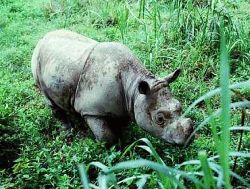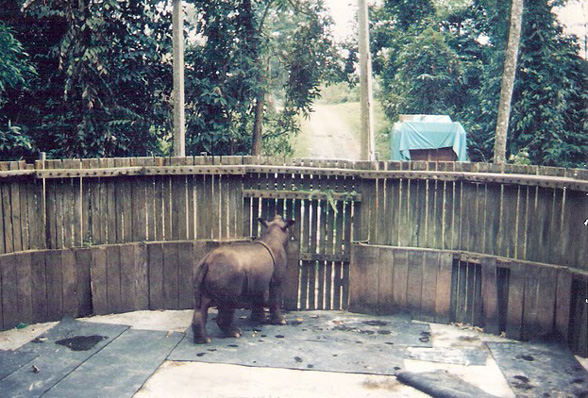The Star, Tuesday February 6, 2007
Though big in size, rhinos are succumbing to pressures inflicted by a much smaller creature – man.
Story by TAN CHENG LI
HE was Sabah’s last hope to boost the dwindling numbers of Sumatran rhinos. But in a tragic event, Tanjung, the only remaining captive male rhino in the state, was killed last August by a falling tree branch. A storm the previous day had inflicted much damage to the Orang Utan Rehabilitation Centre in Sepilok, Sandakan, where the breeding centre is located.
With the death of 15-year-old Tanjung, only the 25-year-old female Gelugob remains. The captive breeding programme in Sabah appears doomed, much like the one at Sungai Dusun, Selangor, which ended abruptly in late 2003 when its whole population of five rhinos was wiped out over a span of 18 days. The cause of death remains disputed between bacterial and parasitic infections.
What will happen to the Sepilok breeding centre and Gelugob is uncertain. Until press time, Sabah Wildlife Department could not be reached for clarification. But trapping another wild male to restock the centre is unlikely to get much public or even scientific support, going by the poor track record of rhinos in captivity.

Captive breeding of Sumatran rhinos has seen little success globally, triggering doubts over the viability of the expensive endeavour.
In the 1980s, some 40 rhinos were trapped from threatened sites in Malaysia and Sumatra, and sent to zoos worldwide to breed but only two calves have been captive-born so far, both at Cincinnati Zoo in the United States. Many of the captive rhinos did not fare well and eventually succumbed to disease and illness.
At Sepilok, the rhinos mated and Gelugob conceived once but aborted after three months.
If the Sepilok breeding programme is continued, Dr Nan Schaffer, an expert in the physiology of rhino reproduction, says the facility, now in disrepair, will need to be enlarged and improved upon.
“It will take several millions to develop the facility to meet standards and bring in expertise as the animals require constant care and monitoring,” says the Chicago-based veterinarian who has worked on rhino breeding in Sabah on numerous occasions since 1990. The conservation group which she founded, SOS Rhino, has been assisting in Sepilok by assessing the health and reproductive integrity of the rhinos, guiding management and husbandry, and conducting research.
Protect in the wild
Dr Nan Schaffer: ‘The status of the animal is critical. To save the species, you need to engage everyone.
With uncertainties shrouding the breeding programme, SOS Rhino programme officer Dr M.S. Thayaparan says efforts now centre on protecting wild rhinos, particularly since the discovery of two juvenile rhino footprints at Tabin Wildlife Reserve meant that they are reproducing.
“If we can better protect their natural environment, they can continue breeding naturally and that would be the best thing.”
Critically endangered, Sumatran rhinos desperately need help. Their future is bleak for their habitat has dwindled, they are shot for their horns and increasing isolation hinders their breeding. Some 300 are all that remain of the species in the only two places where they occur, Sumatra and Malaysia.
The species’ situation in Malaysia is especially desperate – the peninsula has only 70 rhinos left and Sabah, 30 to 40. Schaffer says the rhino in Sabah is even more endangered as it is a subspecies, Dicerorhinus sumatrensis harrissoni, that is found nowhere else since populations in Sarawak and Kalimantan have been wiped out.
For Schaffer, directing conservation efforts on rhinos make sense since they are a “flagship species” – protect them and you will protect other species in the animal kingdom as well.
SOS Rhino’s work in Sabah, funded mainly by foreign zoos and conservation groups, includes five rhino patrol units with rangers to guard the 48,000ha Tabin reserve against poachers and gather data on rhino numbers, food sources and threats.
While SOS Rhino covers Tabin, the other group championing for rhino preservation in Sabah, WWF, focuses on the Danum Valley Conservation Area. Both sites are Sabah’s last rhino strongholds.
Risks persist
The rhinos in Danum Valley, meanwhile, are in a precarious state. The reserve is enveloped by the logging compartments of Malua and Ulu Segama forests and rhinos have been found to inhabit both the protected area and those earmarked for logging.
“Our surveys show Malua and Ulu Segama to be key rhino habitats,” says WWF project manager Raymond Alfred. “Logging, even if using reduced impact techniques, should not be allowed as it can destroy salt licks and mud volcanoes which wildlife such as pigs, rhinos and elephants depend upon for certain minerals.”
He says a new logging road just 1.5km north of Danum Valley raises encroachment risks. Furthermore, boundaries are demarcated only on maps and not in the forest, so hunters issued with permits for Ulu Segama can claim ignorance after entering the reserve.
Under the RM5mil Honda-funded Rhino Rescue project, WWF has formed three rhino patrol units with 12 rangers each to guard and survey Danum Valley and the adjacent forest.
Surveys also show isolated rhino groups in pockets of forests too small to sustain the animals. To safeguard one of these scattered groups, Alfred says the state government will gazette a patch of stateland into a “forest corridor” to link the fragmented forest to Tabin.
A similar plan for another isolated rhino group outside Kulamba wildlife reserve, however, will require more talks as the proposed corridor sits on privately owned plantations.
WWF is embarking on a similar rhino conservation project in Belum forest reserve, Perak, which harbours some 10 rhinos. The five-year Honda-funded project will also see the formation of rhino patrol units to check on poachers and conduct rhino surveys.
A community programme initiated by SOS Rhino in Tabin, meanwhile, employs locals for the conservation project, encourages them to start tourism activities, fund students in wildlife conservation studies, and ropes in plantation owners to monitor encroachers, especially on land bordering the reserve.

“The status of the animal is critical. To save the species, you need to engage everyone … plantation operators, land owners, businesses, politicians, communities and scientists.
